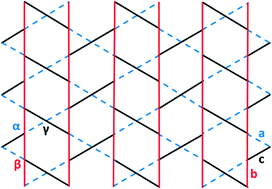Structural phase transitions in the kagome lattice based materials Cs2−xRbxSnCu3F12 (x = 0, 0.5, 1.0, 1.5)†
Abstract
The solid solution Cs2−xRbxSnCu3F12 (x = 0, 0.5, 1.0, 1.5) has been investigated crystallographically between 100 and 300 K using synchrotron X-ray powder diffraction and, in the case of x = 0, neutron powder diffraction. For Cs2SnCu3F12 (x = 0), there is a structural transition from the previously reported room temperature rhombohedral symmetry (R![[3 with combining macron]](https://www.rsc.org/images/entities/char_0033_0304.gif) m) to monoclinic (P21/n) symmetry at 170 K. This transformation is repeated for the x = 0.5 composition, but with an increased transition temperature of 250 K. For x = 1.0 the monoclinic phase is found at 300 K, suggesting that the transition temperature is increased even further. For x = 1.5 a different behaviour, more akin to that previously reported for Rb2SnCu3F12, is found: a single phase transition between rhombohedral symmetry (R
m) to monoclinic (P21/n) symmetry at 170 K. This transformation is repeated for the x = 0.5 composition, but with an increased transition temperature of 250 K. For x = 1.0 the monoclinic phase is found at 300 K, suggesting that the transition temperature is increased even further. For x = 1.5 a different behaviour, more akin to that previously reported for Rb2SnCu3F12, is found: a single phase transition between rhombohedral symmetry (R![[3 with combining macron]](https://www.rsc.org/images/entities/char_0033_0304.gif) ) and triclinic symmetry (P
) and triclinic symmetry (P![[1 with combining macron]](https://www.rsc.org/images/entities/char_0031_0304.gif) ) is found at 280 K. In agreement with previous single crystal studies, Cs2SnCu3F12 powder exhibits strong antiferromagnetic interactions (Θ ~ −268 K) and long-range magnetic order at TN ~ 19.3 K. The finite magnetic moment observed for T < TN might be explained by a Dzyaloshinskii–Moriya interaction, due to the lowering of symmetry from rhombohedral to monoclinic, which was not suggested in the earlier single crystal study.
) is found at 280 K. In agreement with previous single crystal studies, Cs2SnCu3F12 powder exhibits strong antiferromagnetic interactions (Θ ~ −268 K) and long-range magnetic order at TN ~ 19.3 K. The finite magnetic moment observed for T < TN might be explained by a Dzyaloshinskii–Moriya interaction, due to the lowering of symmetry from rhombohedral to monoclinic, which was not suggested in the earlier single crystal study.


 Please wait while we load your content...
Please wait while we load your content...